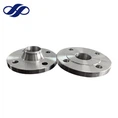A coupler and a flange are both types of pipe fittings, but they serve different purposes and have distinct characteristics. Understanding the differences between these two fittings can help you choose the right one for your application.
A coupler is a type of fitting that is used to connect two lengths of pipe or tubing. Couplers are available in a variety of materials, including metal, plastic, and rubber, and they come in a range of sizes to fit different diameter pipes. Couplers are used to extend the length of a pipe or to connect two pipes at a right angle. They are usually threaded on both ends, making it easy to install and secure them in place.
A flange, on the other hand, is a type of fitting that is used to connect pipes or tubes to a flat surface or to another pipe or tube. Flanges are typically made of metal and have a circular shape with a raised surface that is designed to accommodate a gasket and bolts. The flange is bolted to the surface or to another flange, creating a secure and leak-proof connection.
There are several types of flanges, including slip-on flanges, welding neck flanges, lap joint flanges, socket welding flanges, and threaded flanges. Each type of flange is designed for a specific purpose and has unique features that make it suitable for different applications. For example, slip-on flanges are easy to install and are commonly used in low-pressure applications, while welding neck flanges are typically used in high-pressure applications because they provide a strong, secure connection.
In summary, a coupler is used to connect two pipes or tubes, while a flange is used to connect a pipe or tube to a flat surface or to another pipe or tube. When choosing between a coupler and a flange, it is important to consider the specific requirements of your application, including the pressure, temperature, and fluid or gas that will be flowing through the pipes, as well as the type of connection you need to make. This information will help you determine the most appropriate type of fitting for your application.





